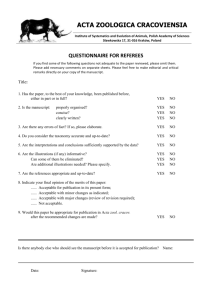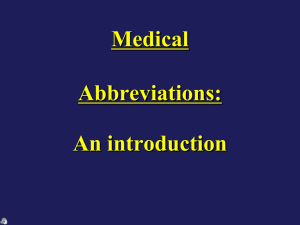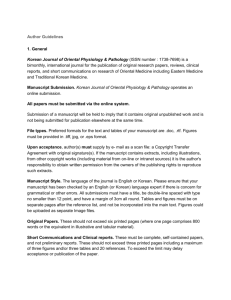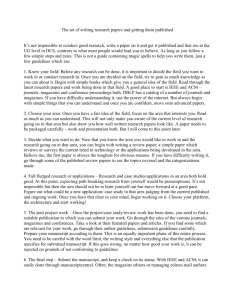Contents - APA Style
advertisement
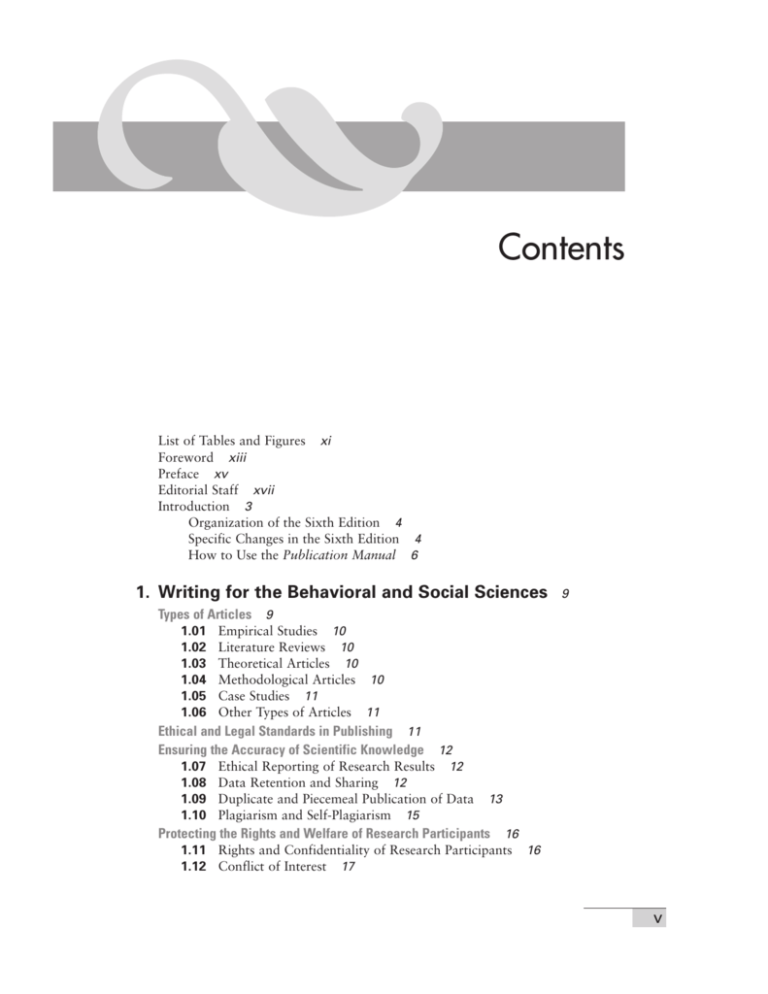
Contents List of Tables and Figures xi Foreword xiii Preface xv Editorial Staff xvii Introduction 3 Organization of the Sixth Edition 4 Specific Changes in the Sixth Edition 4 How to Use the Publication Manual 6 1. Writing for the Behavioral and Social Sciences 9 Types of Articles 9 1.01 Empirical Studies 10 1.02 Literature Reviews 10 1.03 Theoretical Articles 10 1.04 Methodological Articles 10 1.05 Case Studies 11 1.06 Other Types of Articles 11 Ethical and Legal Standards in Publishing 11 Ensuring the Accuracy of Scientific Knowledge 12 1.07 Ethical Reporting of Research Results 12 1.08 Data Retention and Sharing 12 1.09 Duplicate and Piecemeal Publication of Data 13 1.10 Plagiarism and Self-Plagiarism 15 Protecting the Rights and Welfare of Research Participants 16 1.11 Rights and Confidentiality of Research Participants 16 1.12 Conflict of Interest 17 v vi CONTENTS Protecting Intellectual Property Rights 18 1.13 Publication Credit 18 1.14 Reviewers 19 1.15 Author’s Copyright on an Unpublished Manuscript 1.16 Planning for Ethical Compliance 20 2. Manuscript Structure and Content 19 21 Journal Article Reporting Standards 21 Manuscript Elements 23 2.01 Title 23 2.02 Author’s Name (Byline) and Institutional Affiliation 2.03 Author Note 24 2.04 Abstract 25 2.05 Introduction 27 2.06 Method 29 2.07 Results 32 2.08 Discussion 35 2.09 Multiple Experiments 36 2.10 Meta-Analyses 36 2.11 References 37 2.12 Footnotes 37 2.13 Appendices and Supplemental Materials 38 Sample Papers 40 3. Writing Clearly and Concisely 23 61 Organization 61 3.01 Length 61 3.02 Organizing a Manuscript With Headings 62 3.03 Levels of Heading 62 3.04 Seriation 63 Writing Style 65 3.05 Continuity in Presentation of Ideas 65 3.06 Smoothness of Expression 65 3.07 Tone 66 3.08 Economy of Expression 67 3.09 Precision and Clarity 68 3.10 Linguistic Devices 70 3.11 Strategies to Improve Writing Style 70 Reducing Bias in Language 70 General Guidelines for Reducing Bias 71 Guideline 1: Describe at the Appropriate Level of Specificity Guideline 2: Be Sensitive to Labels 72 Guideline 3: Acknowledge Participation 73 Reducing Bias by Topic 73 3.12 Gender 73 3.13 Sexual Orientation 74 3.14 Racial and Ethnic Identity 75 71 CONTENTS 3.15 Disabilities 76 3.16 Age 76 3.17 Historical and Interpretive Inaccuracies 76 Grammar and Usage 77 3.18 Verbs 77 3.19 Agreement of Subject and Verb 78 3.20 Pronouns 79 3.21 Misplaced and Dangling Modifiers and Use of Adverbs 3.22 Relative Pronouns and Subordinate Conjunctions 83 3.23 Parallel Construction 84 4. The Mechanics of Style 87 Punctuation 87 4.01 Spacing After Punctuation Marks 87 4.02 Period 88 4.03 Comma 88 4.04 Semicolon 89 4.05 Colon 90 4.06 Dash 90 4.07 Quotation Marks 91 4.08 Double or Single Quotation Marks 92 4.09 Parentheses 93 4.10 Brackets 94 4.11 Slash 95 Spelling 96 4.12 Preferred Spelling 96 4.13 Hyphenation 97 Capitalization 101 4.14 Words Beginning a Sentence 101 4.15 Major Words in Titles and Headings 101 4.16 Proper Nouns and Trade Names 102 4.17 Nouns Followed by Numerals or Letters 103 4.18 Titles of Tests 103 4.19 Names of Conditions or Groups in an Experiment 4.20 Names of Factors, Variables, and Effects 104 Italics 104 4.21 Use of Italics 104 Abbreviations 106 4.22 Use of Abbreviations 106 4.23 Explanation of Abbreviations 107 4.24 Abbreviations Accepted as Words 107 4.25 Abbreviations Used Often in APA Journals 108 4.26 Latin Abbreviations 108 4.27 Scientific Abbreviations 108 4.28 Other Abbreviations 110 4.29 Plurals of Abbreviations 110 4.30 Abbreviations Beginning a Sentence 111 104 81 vii viii CONTENTS Numbers 111 4.31 Numbers Expressed in Numerals 111 4.32 Numbers Expressed in Words 112 4.33 Combining Numerals and Words to Express Numbers 4.34 Ordinal Numbers 113 4.35 Decimal Fractions 113 4.36 Roman Numerals 114 4.37 Commas in Numbers 114 4.38 Plurals of Numbers 114 Metrication 114 4.39 Policy on Metrication 114 4.40 Style for Metric Units 115 Statistical and Mathematical Copy 116 4.41 Selecting Effective Presentation 116 4.42 References for Statistics 116 4.43 Formulas 116 4.44 Statistics in Text 116 4.45 Statistical Symbols 117 4.46 Spacing, Alignment, and Punctuation 118 Equations 123 4.47 Equations in Text 123 4.48 Displayed Equations 123 4.49 Preparing Statistical and Mathematical Copy 124 5. Displaying Results 125 General Guidance on Tables and Figures 125 5.01 Purposes of Data Displays 125 5.02 Design and Preparation of a Data Display 126 5.03 Graphical Versus Textual Presentation 126 5.04 Formatting Tables and Figures 127 5.05 Table and Figure Numbers 127 5.06 Permission to Reproduce Data Displays 128 Tables 128 5.07 Conciseness in Tables 128 5.08 Table Layout 128 5.09 Standard Forms 129 5.10 Relation of Tables and Text 130 5.11 Relation Between Tables 130 5.12 Table Titles 133 5.13 Table Headings 133 5.14 Table Body 137 5.15 Confidence Intervals in Tables 138 5.16 Table Notes 138 5.17 Ruling of Tables 141 5.18 Presenting Data in Specific Types of Tables 141 5.19 Table Checklist 150 Figures 150 5.20 Principles of Figure Use and Construction 150 112 CONTENTS 5.21 Types of Figures 151 5.22 Standards for Figures 152 5.23 Figure Legends and Captions 158 5.24 Planning Figures 161 5.25 Preparation of Figures 161 Presenting Electrophysiological, Radiological, and Other Biological Data 5.26 Electrophysiological Data 162 5.27 Radiological (Imaging) Data 162 5.28 Genetic Data 165 5.29 Photographs 165 5.30 Figure Checklist 167 6. Crediting Sources 161 169 When to Cite 169 6.01 Plagiarism 170 6.02 Self-Plagiarism 170 Quoting and Paraphrasing 170 6.03 Direct Quotation of Sources 170 6.04 Paraphrasing Material 171 6.05 Direct Quotations of Online Material Without Pagination 171 6.06 Accuracy of Quotations 172 6.07 Changes From the Source Requiring No Explanation 172 6.08 Changes From the Source Requiring Explanation 172 6.09 Citations Within Quotations 173 6.10 Permission to Quote, Reprint, or Adapt 173 Citing References in Text 174 6.11 One Work by One Author 174 6.12 One Work by Multiple Authors 175 Basic In-Text Citation Styles 176 6.13 Groups as Authors 176 6.14 Authors With the Same Surname 176 6.15 Works With No Identified Author or With an Anonymous Author 176 6.16 Two or More Works Within the Same Parentheses 177 6.17 Secondary Sources 178 6.18 Classical Works 178 6.19 Citing Specific Parts of a Source 179 6.20 Personal Communications 179 6.21 Citations in Parenthetical Material 179 Reference List 180 6.22 Construction of an Accurate and Complete Reference List 180 6.23 Consistency 181 6.24 Using the Archival Copy or Version of Record 181 6.25 Order of References in the Reference List 181 6.26 References Included in a Meta-Analysis 183 Reference Components 183 6.27 Author and Editor Information 184 ix x CONTENTS 6.28 6.29 6.30 6.31 6.32 Publication Date 185 Title 185 Publication Information 186 Electronic Sources and Locator Information 187 Providing Publication Data for Electronic Sources 189 7. Reference Examples 193 Types and Variations 193 Examples by Topic 198 7.01 Periodicals 198 7.02 Books, Reference Books, and Book Chapters 202 7.03 Technical and Research Reports 205 7.04 Meetings and Symposia 206 7.05 Doctoral Dissertations and Master’s Theses 207 7.06 Reviews and Peer Commentary 208 7.07 Audiovisual Media 209 7.08 Data Sets, Software, Measurement Instruments, and Apparatus 210 7.09 Unpublished and Informally Published Works 211 7.10 Archival Documents and Collections 212 7.11 Internet Message Boards, Electronic Mailing Lists, and Other Online Communities 214 Appendix 7.1: References to Legal Materials 216 A7.01 General Forms 216 A7.02 Text Citations of Legal Materials 217 A7.03 Court Decisions (Bluebook Rule 10) 217 A7.04 Statutes (Bluebook Rule 12) 219 A7.05 Legislative Materials (Bluebook Rule 13) 221 A7.06 Administrative and Executive Materials (Bluebook Rule 14) 223 A7.07 Patents 224 8. The Publication Process 225 Editorial Process 225 8.01 Peer Review 225 8.02 Manuscript Acceptance or Rejection 226 Author Responsibilities 228 8.03 Preparing the Manuscript for Submission 228 8.04 Complying With Ethical, Legal, and Policy Requirements 8.05 Publisher Policy Requirements 236 8.06 Working With the Publisher When the Manuscript Has Been Accepted 239 8.07 Checklist for Manuscript Submission 241 231 Appendix: Journal Article Reporting Standards (JARS), Meta-Analysis Reporting Standards (MARS), and Flow of Participants Through Each Stage of an Experiment or Quasi-Experiment 245 References Index 259 255

